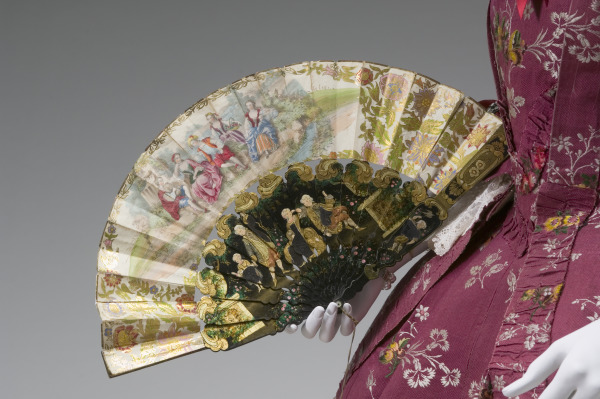The Mint Museum has pieces of its collection spread across two buildings; Mint Museum Uptown and Mint Museum Randolph. These collections can be seen on view alongside our special exhibitions.
The Mint Museum is working diligently to ensure that all objects from our collection are represented on our website, at this time only a portion are available for view.
lacquered lacquer wood
Not currently on view
Gift of the Mint Museum Auxiliary, donated by Mrs. Ann Over
Among women’s fashions of the eighteenth century, two styles of robes, or dresses, were highly popular. The robe à la Française, or sacque gown, combined a taut bodice with folds of fabric that extended from the back neckline down to the hem of the gown. A robe à la Anglaise displays a fitted bodice, with a décolleté neckline, and an attached overskirt. The skirt, then called a petticoat, may or may not match the fabric of the dress. These popular styles paired a narrow waistline with wide, full skirts which extended out from each side. This volume was supported by panniers (hoops) made of heavy cotton or linen and metal rods or reed strips. The narrow torso was created (constricted) by a lady’s stays, or corset, that was made of heavy linen or stout cotton with shoulder straps, stiffened with inserted whalebones, and laced up the back. After 1770, it was the vogue to tie the overskirt at the sides using interior cords and/or ribbons or buttons to form three large poufs. This style was reportedly in response to the 1772 division of Poland into three kingdoms and is called robe à la Polonaise.
Accession Number: 1986.81.2
Measurements:
Copyright Information:
public domain
In order to access a high-resolution image, please submit a request via the Mint’s Reproduction Request Form. Fees may apply.

All records for works of art published on mintmuseum.org have been reviewed by curatorial staff but may be incomplete. Our collections database comprises information gathered over the museum’s history; consequently, some records may be missing information, include offensive or discriminatory language, or reflect outdated ideas and analyses. The Mint is committed to addressing these issues and revising our records so as to maintain the highest possible degree of accuracy in accordance with scholarly standards.
If you would like to suggest improvements to a record, please submit your feedback here.
The Museum assumes no responsibility for infraction of copyright laws, invasion of privacy or improper and /or illegal use that may arise from reproduction of this image. The user assumes full responsibility for the use of images obtained from the Museum, to obtain permission from copyright holders where applicable and to hold harmless the Museum and its agents against any and all damages and claims arising or resulting from the use of the images.